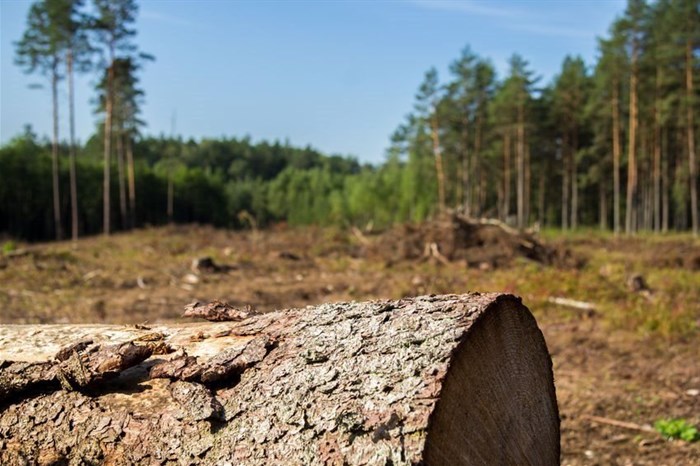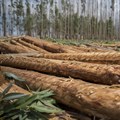Our planet is faced with both an environmental crisis and a housing crisis. There is, however, a sector that is overlooked as a viable, renewable and long-term solution to climate change and urbanisation.

Source: ©Joerg Huettenhoelscher via
123RFHaving recently attended the annual Wood Conference in Cape Town at the end of February, I was inspired to hear and see how timber is being used successfully in the built environment, not just in the northern hemisphere but also on home soil. From modern homes in an off-the-grid community in Mogale City to a learning centre in the Drakensberg, from a new home in Knysna or a rooftop extension to a Johannesburg home to the Green Point Education dome in Cape Town.
At the mention of wood, your mind’s eye might only be able to conjure an image of a log cabin or “wendy house”, or perhaps a roof truss or timber flooring. It’s unlikely that you imagined a multi-storey building made from cross-laminated timber (CLT), a type of engineered wood for mass timber construction.
You’re forgiven, considering that less than 1% of new South African houses use timber as the primary construction material. By comparison, some 90% of new houses in New Zealand are made of timber.
Strengthening timber's position
As a sector trying to promote the adoption of mass timber, we are faced with a long-held belief that brick-and-mortar is the only way to build homes, schools and clinics. There are many misconceptions, not least of which are strength, durability, fire safety, and cost. Many people view wood as rudimentary or weak.
Mass timber uses technological advancements to engineer wood to have a stronger strength-to-weight ratio. In the case of CLT, thin layers of timber are laid crossways before being bonded and compressed together.
It’s been said that wood isn’t manufactured, it grows. From a South African perspective, the wood is sourced from sustainably managed tree plantations.
The forest products sector is the only one to have the trifecta of green solutions when it comes to the carbon sequestration by trees in managed forests, carbon storage in its products and the substitution of carbon-intensive materials with wood-based products.
The construction sector accounts for 35-40% of global energy-related CO2 emissions, with a large proportion (embodied emissions) attributable to the extraction, processing and energy-intensive manufacturing of building products. The other main source is operational emissions from heating, cooling and power generation.
Julia P G Jones and Neal Hockley 28 Aug 2023 Timber boasts a significantly lower carbon footprint compared to traditional building materials like concrete and steel. Timber also maintains a carbon-negative status throughout its lifecycle, from initial production to disposal, and it sequesters more carbon than it emits during processing and installation.
Our colleagues at the Stellenbosch University, Prof Brand Wessels and Dr Philip Crafford have published various pieces of research, highlighting the advantages of increased timber use in South Africa. Basic modelling analyses show that if the market share of wood-based buildings increases to 20% of new constructions, the embodied energy and global warming potential of the residential building sector could decrease by 4.9%.
As our population and economic migration increase, there is an urgent need to change how we build high-density and single-family housing, quickly, cost-effectively and sustainably.
Driving innovation and growth
There is a climate, economic and even social case for timber, and a significant opportunity for innovation, localisation and employment creation. Several industry players, architects, construction engineers and producers are focused on making engineered wood more accessible to the local market. With this comes the need for upskilling or reskilling, business growth and employment opportunities.
Wood lends itself well to modern, modular and off-site methods of construction, with improved efficiency and performance. Single and multi-storey buildings are prefabricated off-site, allowing for quicker on-site assembly, fewer journeys to and from site (and the associated carbon emissions), and minimised disruption, dust and noise.
Biased towards tried-and-tested steel and concrete, the public and private sectors are reluctant to drive the use of timber in the built environment through procurement policies.
Through initiatives such as the Forestry Master Plan, partnerships with the Department of Trade, Industry and Competition and forward-thinking academia, we want to shift the needle in favour of using locally grown and processed timber.
Both the University of Pretoria and Stellenbosch University have a strong wood science focus, helping to educate a new generation of architects and construction engineers.
Dr Schalk Grobbelaar, senior lecturer and chairperson of the York Timbers Chair in Wood Structural Engineering in the University of Pretoria’s Department of Engineering & Technology Management, is a champion for our cause. He believes that a design-led approach is crucial to successful risk management where timber solutions are used, while also exposing people to possibilities that timber brings.
Empowering industry with technology
Dr Grobbelaar’s team has been focusing on traditional timber frame construction combined with modern CNC machined plywood/OSB modular construction.
Prof Wessels and Dr Crafford have also developed The Wood App, a platform that offers architects, builders and designers access to a host of CPD-accredited courses on local wood standards, materials and best practices.
The sawmilling sector, while small in comparison to other industrial sectors, supplies sawn timber and other products for various applications, from structural timber to moulded and machined products for decking, flooring and ceilings. Many of these sawmills operate in rural or peri-urban areas, providing much-needed employment to thousands.
The uptake of timber represents a massive opportunity for our country and our planet. It’s time to trust in timber.
















































